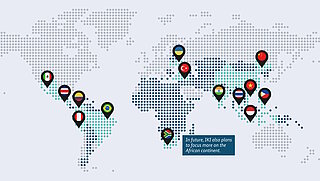Ukraine
Last updated: September 2025
In terms of area, Ukraine is the largest country completely located within Europe. Since the beginning of the large-scale Russian invasion, many people have fled to other countries. Of the original 44 million inhabitants, 38 million still live in Ukraine today. The country has a high potential for economic development. Before the start of Russia's war of aggression against Ukraine, about two-thirds of the employed population worked in the expanding service sector. The number of employees in industry (about a quarter) and agriculture (over 10 per cent) is declining, but is still considerably higher than in Germany.
Due to the fertile black earth soils and the high export rate of agricultural products, Ukraine contributes to ensuring global food security ("bread basket of the world"). The country has a large potential of highly qualified workers.
In the past, electrical and thermal energy in Ukraine was primarily produced from coal, gas and nuclear power. So far, the Russian war of aggression has also destroyed about 60 per cent of the power plant capacities, so that energy has now become very scarce and expensive. This also has an impact on the energy-intensive steel industry, which used to be one of the country's most important economic sectors. When reconstruction begins, the Ukrainian government is planning to focus strongly on renewable energies. However, it is important to improve energy efficiency in buildings, the central heat supply and industry at the same time. Due to the country's large agricultural sector, there is a lot of biomass available that can make a substantial contribution to sustainable energy supply.
The biodiversity in Ukraine is unique in Europe, which is attributable to the country's varied geography. The landscapes range from the Carpathian mountains, (primeval) forests, (forest) steppes, pastures, (salt) meadows and marshlands to the coasts of the Black Sea. The country, which only amounts to six per cent of Europe's surface area, harbours 35 per cent of the continent's biodiversity. This enormous abundance comprises over 70,0000 species, including brown bears, bison, buffaloes, wolves, elk and dolphins. Many of the species are rare or endangered. Some of the species are only native to Ukraine, or only found there now. The effects of the war not only have an impact on the people and infrastructure, but also particularly on the environment as well as on animals and vegetation.
Interface project
All priority countries of the IKI also engage in so-called IKI interface projects, which have permanent project offices in the capital city of the respective country. Alongside their own, country-specific project commission, these interface projects are also tasked with maintaining close contact to environment and climate ministries as well as networking with other relevant ministries in the field of climate and biodiversity policy. Beyond this, the interface projects also work to network all of the IKI projects in the country and region together so as to promote synergies.
In Ukraine, the interface function is represented by the project Supporting Ukraine towards ambitious and integrated climate policy (GreenUkraine).
Project priorities
- IKI interface function supports the networking and cooperation between German und Ukrainian policy makers and institutions, the IKI implementing organisations and the Energy Partnership.
- Support the Ukrainian Government in the 2025 NDC update aligned with the LTS development
- Strengthen the capacities at the Ukrainian Ministry of Environmental Protection and Natural Resources for the management and restoration of biodiversity, strengthening monitoring capacities in line with the updated NBSAP.
- Ukrainian Climate Office (UCO) fosters the implementation of climate policies
In a nutshell
Region: Central, Eastern and South-Eastern Europe
Population: 37.9 million (World Bank, 2024)
CO2eq emissions (incl. LUCF): 165.6 million t (ClimateWatch, 2022)
CO2eq emissions per capita (incl. LUCF): 4 t (ClimateWatch, 2022)
Total energy supply (IEA, 2023):
- 21 % Coal
- 29 % Gas
- 2 % Hydro
- 24 % Nuclear
- 1 % Wind, Solar etc.
- 7 % Biofuels / Waste
- 17 % Oil
- 18 & RE in electricity mix (1 % Wind, 4 % PV)
IKI projects in the country (last updated: August 2025):
- bilateral: 14 ongoing, 12 completed
- regional: 3 ongoing, 7 completed
- global: 8 ongoing, 2 completed
IKI partner ministries:
- Ministry of Economy, Environment and Agriculture
- Ministry of Energy
- Ministry for the Development of Communities and Territories
Links
The IKI Strategy
The IKI wants to maximise its impact on climate action and biodiversity conservation. To this end, it concentrates its funding activities on prioritised fields of action within the four funding areas. Another key element is the close cooperation with selected partner countries, especially with the IKI’s priority countries.
Insights into the project work
- Decentralized Renewable Energy Solutions for Social and Public Infrastructure in Ukraine
- Renewable Energy Solutions Programme (“RES Programme”)
- Reform of the District Heating Sector in Ukraine (ReWarm)
- Accelerating NDC and promoting sustainable bioenergy, agri and land-use practices in Ukraine
- Conservation of highly valuable primeval and old-growth forests in selected national parks in the Ukrainian Carpathians
- BAT for Ukraine - Improving the framework conditions for the implementation of the European Directive 2010/75/EC on industrial emissions and promoting the use of best available techniques (BAT) in industry
- Supporting the national energy efficiency fund and the climate-friendly reform agenda (S2I) in Ukraine
- Energy Efficiency Support Program for Ukraine – EE4U
- Supporting the implementation of an emissions trading scheme in Ukraine
IKI partner countries
The link has been copied to the clipboard








![[Translate to English:]](/fileadmin/_processed_/1/9/csm_20231120_eroeffnung_klimabuero_GIZ_Gate_Agency_443014c5e2.jpg)








